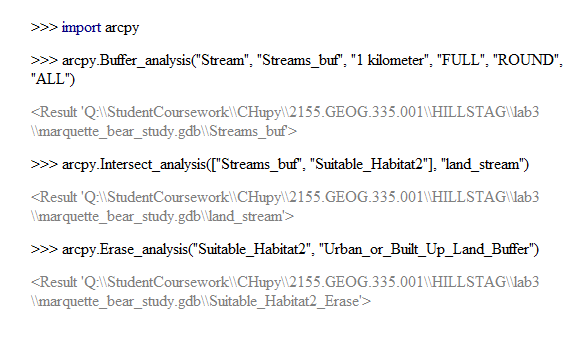The goal of this lab was generate a final map indicating suitable habitat for bears within Marquette County, MI using geoprocessing tools within ArcMap.
Background
There were eight objectives to complete within this lab, which were created to provide exposure to using tools within the ArcMap toolbox. Through this lab I was required to use tools such as Intersect, Buffer, Erase, and Dissolve to determine which habitat was most suitable for bears based on provided criteria. I documented the processes I used to generate my final output map within a data flow table. During this lab I also practiced using the Python Script tool.
Methods
1) Data Flow Model Process
My first task was to create a new feature class of suitable habitat for bears, therefore I choose to intersect the bear locations and landtype feature class. Using this output, I summarized the field indicating habitat type, to find which habitat type had the most amount of bear sightings. The top three results were Mixed Forest Land, Forested Wetlands, Evergreen Forest Lands.
My second task was to create a feature class that would help me determine how many of bears were observed within 500 meters of a stream. For this, I was able to use select by location to determine how many bears were within 500 meters of a stream. The total was about 72%, which suggests that rivers are a critical part of their habitat. From here I used the buffer tool to create a feature class that had an area of 500 meters around all streams.
My next task was to create a feature class for suitable bear habitat, which I now knew should include the top three habitat types, as well has stream habitat. To create this, I selected the top three habitat types through Select by Attribute. Next, I intersected the new steams with buffers feature with the selected habitat types. The dissolve to was necessary to use on the output because internal boundaries needed to be erased.
The following objective was to find which DNR management lands lie within the suitable habitat areas. The intersect tool was used to generate the output, followed by the dissolve tool to remove the internal boundaries.
Lastly, I was required to create a feature class of the DNR management areas within the suitable habit that are at least 5 kilometers away from Urban Areas. For this, I chose to create a feature class of the Urban Areas. From there I ran the buffer tool to create an area of 5 kilometers around the data points. I finished this task by running the erase tool, within the DNR management areas as my input, while erasing the Urban Areas feature class. This created an output of DNR areas away from Urban space.
2) Using Python
Results
My results suggest that streams are a critical feature with bear habitat. Additionally, it appears that the majority of bears were observes is in the northwestern and central portion of Marquette County, and therefore mostly away from the urban areas within the southern portion of the state. Additionally, I was able to determine that Mixed Forest Land, Forested Wetlands, Evergreen Forest Lands are the habitats were bears primarily are observed. These factors should all be taken into account when developing new protected bear habitat areas. The map indicates there are currently no DNR management sites in the northeaster portion of the county where bear prevalence increases. If the DNR were to construct additional sites, the area of suitable habitat in the northwestern portion of the map should be high considered.
Figures
 |
| Figure 1: Lab 3 data flow map. This indicates which tool were required to create the map, as well as the order they were used it. |
 |
| Figure 2: Map of Suitable Bear Habitat in Marquette County, WI generated using data flow model from figure 1. |
 |
| Figure 3: Three scripts ran in Python. |
 |
| Figure 4: Map output of the three python scripts within figure 3. |
The data used in the lab were all downloaded from the Michigan Center for Geographic Information.
- Landcover is from USGS NLCD and retrieved from:(http://www.mcgi.state.mi.us/mgdl/nlcd/metadata/nlcdshp.html)
- DNR management units retrieved from:(http://www.dnr.state.mi.us/spatialdatalibrary/metadata/wildlife_mgmt_units.html)
- Streams data was retrieved from:(http://www.mcgi.state.mi.us/mgdl/framework/metadata/Marque)tte.html)
No comments:
Post a Comment